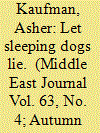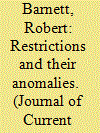| Srl | Item |
| 1 |
ID:
092176


|
|
|
|
|
| Publication |
2009.
|
| Summary/Abstract |
This article argues that the partition of the village of Ghajar between Israel and Lebanon by the Israeli Line of Withdrawal, as determined by the United Nations in 2000, was based on historical and cartographical errors. It demonstrates that the entire village was controlled by Syria until the June 1967 war when Israel occupied it along with the Golan Heights. The article shows that the entire pre-1967 tri-border region of Syria, Lebanon, and Israel suffered from border irregularities that remained dormant until 2000. Finally, the article argues that Ghajar should remain united, pending a Syrian-Israeli peace deal that theoretically would return the Golan Heights to Syria and include Ghajar in its entirety.
|
|
|
|
|
|
|
|
|
|
|
|
|
|
|
|
| 2 |
ID:
118421


|
|
|
|
|
| Publication |
2012.
|
| Summary/Abstract |
In 1994, at a meeting known as the Third Forum on Tibet Work, the Chinese authorities announced a series of restrictions on religious practice in the Tibetan Autonomous Region. Described by many outsiders in terms of abuses of rights, in fact those measures differed in important ways. By analysing the target, rationale and procedure of these restrictions, it becomes clear that some were relatively routine, while others were anomalous - their purpose was not explained by officials, the source of their authority was not clear, or the restrictions were simply not admitted to at all. These anomalous orders can be linked to major changes in underlying discourses of modernization and development among officials in Tibet at the time. They reflected undeclared shifts in attitudes to religion and cultural difference, and seeded the dramatic worsening in state-society relations that has taken place in Tibetan areas since that time.
|
|
|
|
|
|
|
|
|
|
|
|
|
|
|
|